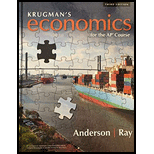
a)
Whether it is wise for a firm to hire more of the input with the highest marginal product and less of the input with the lowest marginal product when it does not have the cost-minimizing combination of inputs.
a)
Explanation of Solution
The hiring of input with the highest marginal product would not be prudent for the company because it would be more expensive than recruiting input with the lowest marginal product. Additionally, the marginal product per dollar is poor with this hiring.
By hiring more of the inputs with lower marginal products, which results in higher marginal products per dollar, and by hiring fewer of the inputs with higher marginal products, which produce lower marginal products per dollar, the company can reduce costs.
Introduction: The change in extra output caused by adding one additional unit of the input factor to the current factors of inputs, such as labor and capital, is referred to as the marginal product of an input or a factor of input.
b)
The cost-minimization rule
b)
Explanation of Solution
The cost-minimization rule states that businesses can modify their input hiring practices to equalize the marginal product per dollar spent for each input unit in order to save costs. The cost-minimization rule primarily assists the company in maximizing profits and ensuring the output level at the lowest cost. It is calculated by dividing the marginal product of labor by the wage of labor, which is equal to the marginal product of capital by the cost of capital or capital rental price.
Introduction: The change in extra output caused by adding one additional unit of the input factor to the current factors of inputs, such as labor and capital, is referred to as the marginal product of an input or a factor of input.
c)
The marginal product of labor per dollar and the marginal product of capital per dollar when a firm hires more labor and less capital.
c)
Explanation of Solution
The marginal product of labor per dollar would fall and the marginal product of capital per dollar would rise if a firm hired more labor and less capital because the marginal return would start to fall with the addition of more units of factor.
As a result, increasing employment would result in a lower marginal return and lower marginal product of labor per dollar.
Because the units of capital that are sacrificed have a lower marginal product than the units of capital that remain, renting less capital would also result in an increase in the marginal product of capital, which would increase the marginal product of capital per dollar. Therefore, the marginal product of capital per dollar would rise by renting less capital.
Introduction: The change in extra output caused by adding one additional unit of the input factor to the current factors of inputs, such as labor and capital, is referred to as the marginal product of an input or a factor of input.
Chapter 72 Solutions
Krugman's Economics For The Ap® Course

 Principles of Economics (12th Edition)EconomicsISBN:9780134078779Author:Karl E. Case, Ray C. Fair, Sharon E. OsterPublisher:PEARSON
Principles of Economics (12th Edition)EconomicsISBN:9780134078779Author:Karl E. Case, Ray C. Fair, Sharon E. OsterPublisher:PEARSON Engineering Economy (17th Edition)EconomicsISBN:9780134870069Author:William G. Sullivan, Elin M. Wicks, C. Patrick KoellingPublisher:PEARSON
Engineering Economy (17th Edition)EconomicsISBN:9780134870069Author:William G. Sullivan, Elin M. Wicks, C. Patrick KoellingPublisher:PEARSON Principles of Economics (MindTap Course List)EconomicsISBN:9781305585126Author:N. Gregory MankiwPublisher:Cengage Learning
Principles of Economics (MindTap Course List)EconomicsISBN:9781305585126Author:N. Gregory MankiwPublisher:Cengage Learning Managerial Economics: A Problem Solving ApproachEconomicsISBN:9781337106665Author:Luke M. Froeb, Brian T. McCann, Michael R. Ward, Mike ShorPublisher:Cengage Learning
Managerial Economics: A Problem Solving ApproachEconomicsISBN:9781337106665Author:Luke M. Froeb, Brian T. McCann, Michael R. Ward, Mike ShorPublisher:Cengage Learning Managerial Economics & Business Strategy (Mcgraw-...EconomicsISBN:9781259290619Author:Michael Baye, Jeff PrincePublisher:McGraw-Hill Education
Managerial Economics & Business Strategy (Mcgraw-...EconomicsISBN:9781259290619Author:Michael Baye, Jeff PrincePublisher:McGraw-Hill Education





